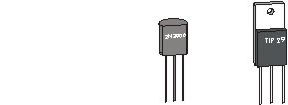
|
|
TransistorsA transistor is a semiconductor device capable of strengthening a small input signal or switching a larger load in response to a small input signal. In most applications they have replaced vacuum tubes because they are smaller, faster, cheaper, more energy efficient and cooler. Bipolar Junction TransistorThe junction transistor is formed by sandwiching a layer of one type of semiconductor between two layers of another type. Thus we have both NPN transistors and PNP transistors. The centre layer is known as the base, and the other two layers are called the collector and the emitter. A metal conductor is attached to each layer so the transistor can be connected to other devices. Packages
|
